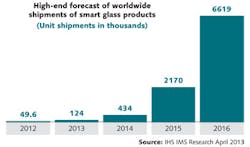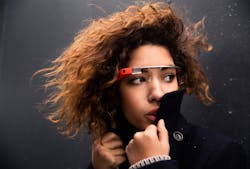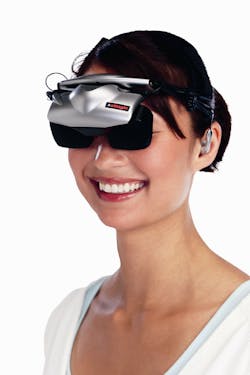PHOTONICS APPLIED: DISPLAYS: Head-worn displays: Useful tool or niche novelty?
Head-worn displays such as Google Glass from Google's (Mountain View, CA) Project Glass are just now reaching the consumer: the first Google Explorer Editions ($1500) are rolling off the assembly line to a select audience of trial users. And while initial responses have been positive, the future seems uncertain for these "augmented reality" devices—perhaps much like the 'tenuous' penetration of 3D technology in cinema and smart devices.1
In April 2013, market research firm IHS iSuppli (El Segundo, CA) forecast that nearly 10 million smart glasses would ship between 2012 and 2016 (see Fig. 1).2 Initial revenues, they say, will be driven by sales to developers, with sales increasing 250% in 2014 as Google Glass products become publicly available.
But Google isn't the only company betting on a solid future for these photonic-intensive electronic gadgets: the Vuzix (Rochester, NY) M100 Smart Glasses are under $500; Epson's (Long Beach, CA) Moverio BT-100 display is designed for in-home video viewing; and Innovega's (Bellevue, WA) iOptic augmented reality contact lenses are several years away (2015), but attempt to reduce the size of the head-worn device by projecting information directly into the wearer's eye. There is even a hands-free Golden-i headset developed by Kopin Corporation (Westboro, MA) with multilingual speech recognition, gesture interface, on-demand night vision, infrared thermal vision, facial recognition, GPS, and passive health monitoring. A Golden-i Police Pro application from Ikanos Consulting (West Bridgford, England) could give this technology real longevity.3
Nomenclature
Before launching into commercial (and emerging) head-worn display options and non-proprietary technology features, a note about terminology would be helpful. Specifically, head-worn display (HWD) products are also named head-mounted displays (HMDs), head-up or heads-up displays (HUDs), augmented reality (AR) devices or displays, smart glasses, digital glasses, eyeglass displays, or even wearable computers. Is there a difference in these named technologies?
"It is generally agreed that heads-up displays or HUDs are those devices intended for military/aircraft use to augment the pilot's other available navigation devices," says Jannick Rolland, professor of Optics and Biomedical Engineering and director of both the R.E. Hopkins Center for Optical Design & Engineering and the planned NSF Center for Freeform Optics, all in The Institute of Optics at the University of Rochester (Rochester, NY). Rolland has been developing head-worn display device technology for nearly 23 years—some in partnership with industry players NVIS (Reston, VA) and Revision Military (Essex Junction, VT)—and continues to advance HWD technology. In recent years, she partnered with Optical Research Associates (now Synopsys, Mountain View, CA) to create a path for real-time warping of stereo distortion-free images as well as a wireless version of the company's HWD prototype.4-6
"Head-worn displays or HWDs refer to those devices meant for more consumer-related and sports applications like surfing the Internet, checking the time or vital statistics, and getting alerts for appointments using a device worn on the head that acts like a computer to 'augment' the user's surroundings," adds Rolland. "That is, an 'augmented reality' device is a more futuristic name for any HWD products that are meant to easily and seamlessly integrate information into the user's field of view. Currently, Google is on a path to commercialize AR HWDs, and many other industry giants are on that similar path."7
Note that many consumer devices are still named "heads-up displays" even though they are not used in a military/defense application; indeed, the nomenclature confusion will subside as the early adoption phase passes for this personal display technology. Due to the proprietary nature of military HUD devices, the discussion that follows is concerned primarily with consumer HWD applications.
A day in the life
You're getting ready to step outside and take the bus to work and wouldn't want to forget your smartphone—and smart glasses. You slip them on and immediately get a visual text alert in your field of view and an audio message reminding you of your 9 am teleconference. You have a little time while sitting on the bus, so you call up your HWD Facebook app and find out what's happening by using eye or voice cues to scroll through the postings viewed in your glasses as you note the long lines at the Starbucks on the next corner. You play that hilarious cat video again and call up your Twitter app to let the world know just how funny it is by Tweeting the YouTube video link by typing it into your smartphone. Somehow, you've managed to strike up a conversation with the person sitting next to you and so use your HWD to take a picture of them and apply facial recognition software (and hopefully, their verbal permission) to friend them on Facebook.8 For lunch today, you'll do the healthy thing and head to the gym where your smart glasses will display your current weight, respiration rate, and other vitals you've programmed into the health monitor that interfaces with your glasses.
While the scenario here is hypothetical and representative of what some consumer-targeted smart glasses intend to do, Recon Instruments (Vancouver, BC, Canada) launched the first consumer HUDs for sports enthusiasts in late 2010. Precision GPS and altimeters guide ski enthusiasts, for example, with 1 m precision as their MOD Live HUD displays speed, vertical descent, and jump airtime while avoiding soggy paper trail maps. Inserted into any Recon Ready goggle, MOD Live gives wearers an 84° unobstructed view; prism optics project microdisplay data to appear as if viewed on a 14 in. screen from a distance of 5 ft. Announced at the May 2013 Google I/O developer's conference, the next-generation Recon Jet is targeted at a broader consumer audience and anticipated to be faster and smaller with live activity tracking, video streaming, web and smartphone connectivity, and Facebook integration.
Perhaps the most hyped of all HWD devices is Google Glass-a monocular display worn over one ear that transmits images and videos to a small screen (0.75 in. deep, 0.375 in. wide and tall, or half an inch at the diagonal) situated between your eyebrow and upper lid (see Fig. 2). The wearer glances up and to the right to view the display with a resolution equivalent to a 25 in. high-definition screen seen from 8 ft away and touch and voice controlled via a bone conduction transducer, according to Internet resources (Google would not provide further technical details citing the beta pre-release status of the product).9In its United States Patent Application 20130044042, however, Google does describe a binocular (assumed future version) HWD "with an external image viewable through the prism" that could incorporate gyroscopes or other sensors and, in alternative embodiments, "the lens elements... may include: a transparent or semi-transparent matrix display, such as an electroluminescent display or a liquid crystal display, one or more waveguides for delivering an image to the user's eyes, or other optical elements capable of delivering an in focus near-to-eye image to the user ... or additionally, a laser or LED source and scanning system could be used to draw a raster display directly onto the retina of one or more of the user's eyes."
"Google Glass is targeted at social activities-take a picture, take a 10-second video, read a tweet, see an SMS text, answer your phone; but Golden-i was developed as a powerful 'hands-free' tool with the sophistication of a Ferrari [or] a Porsche, and as robust as an Abrams tank when required," says Jeff Jacobsen, VP of technology at Kopin Corporation. Water- and dust-resistant Golden-i generation 3.8 headsets from Kopin are operated using voice commands and head movements captured and understood by a nine-axis MEMS tracker, all interconnected to other remote devices and the Internet by WiFi, Bluetooth, and Verizon 4G LTE wireless interfaces (see Fig. 3). The monocular display can be worn below or above the left or right eye and is compatible with reading glasses, safety glasses, hard hats, or helmets. With a quarter high-definition (qHD) full-color transmissive thin-film transistor (TFT) LCD microdisplay (960 × 540 resolution) that looks like a 15 in. laptop screen situated about 18 in. away from the user's eye, Golden-i targets more industrial applications as a computing and communications tool. Incidentally, Vuzix M100 Smart Glasses and Recon goggles and Jet glasses all incorporate Kopin displays, backlights, and in some cases optics, and offer similar functionality to Google Glass.Also with hands-free operation, organic light-emitting diode (OLED)-based bidirectional microdisplay HMD data eyeglasses from the Fraunhofer Research Institution for Organics, Materials and Electronic Devices (COMEDD; Dresden, Germany) won CeBIT's Innovation Award IT among 4900 submissions and will enable a gardener to immediately identify the winged insect that just ate through its petunias by surfing the Internet via "gaze control" or eye tracking.
Because OLED microdisplays integrate highly efficient light sources with photodetectors on a CMOS backplane, the COMEDD HMD device can present and capture images at the same time (see Fig. 4). Its smart glasses incorporate a 640 × 480 VGA-resolution color OLED microdisplay (8 μm square pixels) with a 10.2 mm × 7.7 mm physical display area in a 39.1° (horizontal) × 26.6° (vertical) see-through (50% transparency) field of view. The nested photodiode pixels enable an embedded camera with 128 × 96 pixel resolution.The Fraunhofer COMEDD HMD development team also included Trivisio Prototyping (Trier, Germany) for the binocular, see-through optics design and the Fraunhofer Institute of Optronics, System Technologies and Image Exploitation (IOSB; Karlsruhe, Germany) for its eye-tracking technology. In addition to the OLED microdisplay with embedded photodiodes, the glasses also house a 5.6 × 11.2 mm eye-motion box that captures an image of the user's right pupil and projects it to a photodetector matrix. The embedded camera converts the image to a digital data stream and a mobile computer uses an eye-tracking algorithm to calculate coordinates and extract the user's point of gaze to control the display.
OLED HWD proponents also include eMagin (Bellevue, WA) with its Z800 3DVisor aimed at the PC gaming market (see Fig. 5). "While the product proved to be too bulky for widespread consumer use, the 40 degree diagonal field of view and greater-than-HD WUXGA [1900 × 1200] resolution make eMagin OLEDs the microdisplays of choice for the U.S. Army and military organizations around the world for night-vision goggles, situational awareness HMDs, and thermal weapon sights," says R. Bruce Ridley, eMagin VP of business development and special projects. "Backlight-free, low-power-consumption, active-matrix OLED microdisplays enable head-worn displays with high pixel count, wide field of view, and high contrast."Privacy and distraction?
We've already seen how texting while driving can be deadly. So how about driving while wearing your HWD or even walking down the street? In a recent Insight Media (Norwalk, CT) Display Central article, Phil Wright says that the former primary concern of developers as to whether the "geeky eyewear" would be widely adopted by consumers is now being replaced—as the technology matures and the geek factor becomes less of an issue—by "implications to privacy and safety matters."10
Wright describes how "recent press accounts cite some specific privacy concerns that may or not become hot topics with the emergence of wearable always-on image capture and display devices. For example, several observers have inquired whether it would be appropriate to wear Glass in a public restroom." And as for safety issues, Wright considers that "for recreational eyewear users like skiers and snowboarders, the concern that injuries may result from distracted high-velocity users is legitimate."
Only time will tell how well HWD technology is adopted, and, like cell phones, laws will no doubt be written to control when, where, and how the devices are used. In this early stage of development, Wright says it best when he concludes, "The social norms that should accompany the adoption of such wearable always-on technology are not yet established, understood and widely applied."
REFERENCES
1. See http://bit.ly/11mQOHm; http://bit.ly/yEIHdv; and http://dailym.ai/OMuMTZ.
2. See http://bit.ly/12pAXqF.
3. See http://huff.to/ZXkSXn.
4. J. Rolland and O. Cakmacki, Optics & Photonics News, 20, 4, 20–27 (April 2009).
5. A. S. Bauer, Opt. Exp., 20, 14, 14906–14920 (2012).
6. J. P. Rolland et al., "See-Through Head Worn Display (HWD) Architectures," Handbook of Visual Display Technology, 2145–2170, Springer, New York, NY (2012).
7. See http://bit.ly/11Cl9zi.
8. See http://bit.ly/11zU3Xr.
9. See http://cnet.co/11ONKBm.
10. See http://bit.ly/16Erkd8.

Gail Overton | Senior Editor (2004-2020)
Gail has more than 30 years of engineering, marketing, product management, and editorial experience in the photonics and optical communications industry. Before joining the staff at Laser Focus World in 2004, she held many product management and product marketing roles in the fiber-optics industry, most notably at Hughes (El Segundo, CA), GTE Labs (Waltham, MA), Corning (Corning, NY), Photon Kinetics (Beaverton, OR), and Newport Corporation (Irvine, CA). During her marketing career, Gail published articles in WDM Solutions and Sensors magazine and traveled internationally to conduct product and sales training. Gail received her BS degree in physics, with an emphasis in optics, from San Diego State University in San Diego, CA in May 1986.




